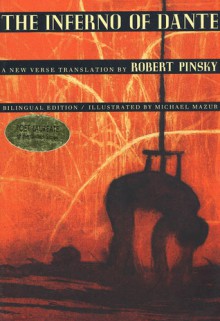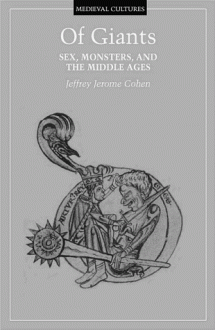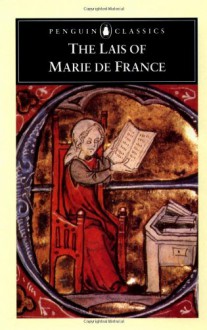


This incredibly dense read would not have been finished had it not been on a required reading list for my class on monsters in Medieval literature. Each chapter required intense concentration in order to understand the complexities of Cohen's observations in relation to the psychology behind beasts and the society who created them.
Cohen goes into great detail on the pre-history of England, how colonization fed the imagination of many, and as a result tales of giants came about in order to illustrate the invasive forces unleashed upon the British Isles. Gogmagog and his herd of kin are examples of this prodigious influence; ultimately the giants are killed, allowing the Christian man to rise above the militaristic enemy, offering a symbol of hope and representing the new England that would rise from the ashes that is subjugation (and the fact that England did in fact recover to become a powerful country is indisputable).
Perhaps the least convincing elements of Cohen's collection of essays was his inclusion of Freudian psychology, in particular his focus on phallic imagery as a means of expressing masculine dominance in England's pre-history, but drawing penises is hardly an antiquated way to show how territorial men can be-- it's rather a familiar habit of men even now. In short, there were many fascinating points although some seemingly based on conjecture and some questionable psychoanalytic psychology.

This is my first experience with lais, brief romances written in verse. I've been a fan of medieval literature chiefly for its outlandish plots and the obscene imagery that consistently seems to contradict the Christian standards of the period. In this particular collection I noticed a popular theme of the "sexual test" where most commonly a man is given the option to refuse the advances of a mystical creature or give into temptation. In almost every account the man fails, giving way to lust. It's interesting that the moral framework of the day does not apply to its literature. In the romantic genre a knight can prove his faithfulness to the Lord AND copulate with a fairy. Really, the best of both worlds. There were so many instances while reading that I questioned the general logic of the characters' actions. For example, two women in two separate tales were detained in a castle, but after years of imprisonment one day they jump to escape, never having realized the whole time that that was a possibility? Or perhaps the strangest is the random appearance of a weasel with a magical flower that revives a princess who later decides that instead of reuniting with her long lost love, she'll become a nun instead. How can it be called the Dark Ages when we're given so much...interesting...material?

You certainly have to love the occasional lyric poetry, especially when it is about the end of everybody’s favourite legendary English king, Arthur Pendragon. Actually, I’m not sure if that is actually his last name, though it seems that this guy, and the legend that surrounds him, is much like Robin Hood – he may have existed, he may not have, but a huge legend has arisen around them while there doesn’t actually seem to be any consistency in these legends. In fact, this particular book contains two contrasting versions of his death, though the common feature is that he was killed by Mordred (though whether Mordred was his son or not is also up in the air because one of them suggests that he is, while the other suggests that he is just naughty lord).
Anyway, these two poems contain literally everything, and it is no wonder that the story of Arthur has been picked up by so many authors and film makers, and the stories that come out of it are vastly different in nature. For instance there was a film from the eighties called Excalibur which focused much more on the fantasy elements, with Excalibur, Merlin, and a tragic end as he searched for the holy grail. Another version (named King Arthur), was set during the times when the Romans pulled out of England, and Arthur was basically a Knight from the other side of the empire and was fighting to stop the Picts from overrunning the England.
There was also this book I remember called The Mists of Avalon, which I remember seeing as a kid, but never getting around to reading it, probably because upon looking at it I came to the conclusion that it was the thickest book ever written – in fact it was huge. Mind you, there are probably much, much thicker books these days, but that one still sits in my mind as being pretty thick. Oh, and we cannot forget to mention this all time classic.
As I previously mentioned there are two versions of the story, both of them dealing with Arthur’s death, so there is no mention of Merlin, nor of the sword, nor of the Lady in the Lake (or the test to remove the sword from the stone). In fact both stories seem to eschew the fantasy elements and come across much more historical. Anyway, the first story deals with Arthur going on conquests across Europe and coming to blows with the Emperor of Rome. He eventually defeats the emperor, however discovers that back in England Mordred has taken the throne for himself. Mind you, after going to war with Rome, Arthur has actually lost a lot of men, but with the handful of men he does have he returns to England, confronts Mordred’s much larger army, and defeats Mordred while dying in the process.
There are a couple of things that come out of this story, one of them being the plot where the King is abroad and the person keeping the throne warm decides to name himself as king. This is something that has happened a number of times in history, but the one event that comes to mind is that of Richard II (of which I have written two blog posts, the second being here). Mind you, I would hardly equate Arthur with Richard, particularly since if it wasn’t for Shakespeare’s play he would probably be little more than a footnote in history – Arthur is a legend. Mind you, it is noticeable that both die, because we can’t have Mordred defeating Arthur and giving us an evil laughter and riding off into the sunset. Mind you, even in Shakespeare’s tragedies the bad guy eventually gets it in the neck. In a way it seems as if you simply cannot have a situation where the bad guy wins, and the good guy simply cannot come back and eventually win the day – it is almost as if it is anathema in literature.
The other thing is how Arthur pretty much conquers Europe. This is taken directly out of History of the Kings of Britain, and seems to attribute the barbarian invasions of Rome to being an invasion let by Arthur. Mind you, Monmouth puts Arthur around 700 AD, which is sometime after Rome collapsed, but it is interesting how we have no record of any legendary king carving out a huge empire in Europe. However, it should also be noted that this is one of those empires that exists only on the personality of a single man, and it appears that after his death the kingdom pretty much disintegrates. Another thing that I have noticed is that Bede seems to have a gap in his Ecclesiastical history right around the time Monmouth has Arthur appear. That’s not to say that I am suggesting Arthur existed because, other than Charlemagne, there doesn’t seem to be any evidence of a king establishing an Empire on the Continent, especially one where the throne was in England.
Mind you, this whole thing reeks of nationalism, yet it is interesting that England did have an identity as far back as the 10th century. Monmouth also suggested that two English Kings were responsible for crossing the channel in around 400 bc, conquering Europe, crossing the Alps, and sacking Rome. Obviously what is happening here is a medieval version of ‘Fake News’, though it is probably better described as being ‘fake history’ (though the Romans seems to have a lot of problems with this fake history) – this is history that really has no substance to it, and no archaeological support. Mind you, writers of history back in those days really didn’t take the academic and scientific approach that we do today (though all history is still tainted by opinion), but rather wrote from the legends that were in vogue.
The second story is pretty much the same (that is about how Arthur died), however it’s focus is more on the love affair between Lancelot and Guenevere. In fact, this affair could be considered one of the greatest affairs in literature (okay, there are probably others, but I really have no interest in stories about love affairs – I would call them forbidden love but it sounds so clichéd – still, something that you can’t have always seems much more desirable than something that you can). Whereas the first story has a lot more action and large scale battles, this one has a lot more intrigue where people are being killed, and then the murder is being covered up, and there is adultery, poisonings, duels, and finally King Arthur’s death.
In a way this is an incredibly painful episode to watch because we all know how it is going to end – badly – especially since Lancelot is one of Arthur’s most trusted knights. However, this episode is set mostly in the court of Camelot, and doesn’t even have any mention of wars and expeditions to foreign lands. Actually, come to think of it there is always the story of David and Bathsheba in the Bible – that’s a pretty well known love affair, but I digress. Anyway, it seems as if the story of Arthur is a story of betrayal, with his wife and best friend having hanky panky behind his back, and Mordred going off and stealing his throne (and dying in the process).
Anyway, before I finish off, I probably should end with this cartoon, especially considering the state of politics these days:


This middle English poem is said by some to be the greatest poem of Middle English literature, however it does have to compete with The Canterbury Tales for that title, something that I am not going to go into since I have not have the chance to read Chaucer's work at this stage. However while the earliest copy of this poem exists on a manuscript dating back to 1400 AD, it was probably circulating much earlier than than. We don't actually know who the author of this poem is (and my suspicion is that it is like The Odyssey - it was an oral poem what was written down at a later date, and copied, and the version that we have is the earliest version of this copied text). The manuscript also contains two other poems, the Pearl and Sir Orfeo (both of which Tolkien translates as well).
While the poem begins in King Arthur's court, during a feast, the opening stanza goes back to the founding of England - Troy. It appears (and I noted that Holinshed, the English Chronicler from whom Shakespeare used as a source for some of his plays) also puts the origin of the British people to Troy. The story is that after Troy fell, Aeneas fled to Italy where he founded a colony and from that colony Romulus and Remus arose and went on to found the city of Rome (or at least Romulus, since since he killed Remus). However, one of Aeneas' general's, Brutus, was not happy with the location, so he left with some followers, sailed to Britain, defeated the Giants, and founded a colony that eventually, after millennia, went on to rule the world. This of course is all legend and there is no historical or archeological evidence to support this ever actually happening (though it does make a ripping yarn).
Anyway, that is beside the point. The poem itself was quite popular and tells the story of Sir Gawain who, at the feast, decides to take the Green Knight's challenge, which is that if somebody where to strike him then they must meet him at the Green Chapel in a year and a day and also be struck. Sir Gawain decides that sounds like a bit of fun and proceeds to lop off his head. However the Green Knight simply picks it up (his head that is) and walks out, telling him that he will see him in a year and a day. So Sir Gawain travels the land and arrives at the castle of Sir Bertilak. Bertilak then heads out out on a hunting trip but before he goes he tells Sir Gawain that if he gives Gawain the proceeds of the hunt, Sir Gawain must give him whatever he got that day. So, while Bertilak is out his wife attempts to seduce Gawain, who resists the temptations, and the first two times he is given a kiss, and the last time he is given a girdle which will protect him from harm. Gawain honours his agreement to Bertilak (with the exception of the Girdle) and then goes out to meet the Green Knight. After the battle, it turns out that the Green Knight is Bertilak.
This poem carries a lot of symbolism which will simply take way too long to explore the subtleties (and for those who are interested, I'll simply refer you to Wikipedia). However, one of the major themes in this poem is chivalry, which is a medieval code of honour for knights. One of the major aspects is honesty and keeping one's words. Gawain does demonstrate his honour by keeping his word to Bertilak (and the Green Knight) however he does fail with handing over the girdle. This is interesting because he keeps the girdle for protection when he meets the Green Knight without actually knowing that he has already met the Green Knight. We also notice that he honours the marriage vows by resisting Bertilak's wifes advances, even though each advance becomes progressively stronger. Some have suggested that the advances of Bertilak's wife reflects Bertilak's hunting trips, as the animals Bertilak hunts become progressively more aggressive.
Another aspect is nature verses civilisation with the Green Knight (and in turn Bertilak) representing nature and Camelot representing civilisation. The Green Knight's entrance to the feast is a reflection of the chaos of nature bursting into the order of civilisation, and Sir Gawain takes the challenge in an attempt to tame nature. However, considering the time this poem was written (the Dark Ages) it is also looking back to a more civilised time (despite doubts as to the actual existence of King Arthur's court). The time in which this poem was composesd was a time of lack of law and there is, in a way the hearers were no doubt longing for the better times.
In this particular work, there are two other poems which I will briefly mention. The first is The Pearl, which is an allegorical dialogue between a knight and a woman about the kingdom of heaven. This poem has a lot of biblical images (which includes the Pearl, a symbol that Christ uses in one of his parables to describe the beauty and value of the kingdom of heaven). The Knight had the pearl, but lost it, and is worried that in losing the pearl he has also lost access to the kingdom of heaven. Some have suggested that the Pearl is probably representing a loved one, such as a child, but I think the allegory in this poem is deeper than that.
The final poem, Sir Orfeo, is a retelling of the Greek story of Orpheus in the underworld (and this is very clear in that Sir Orfeo is a form of Orpheus). The poem is set in Winchester, however in the poem it is also called Thrace (the location in Greece of the original Orpheus myth). In this poem, though, instead of travelling to the underworld to rescue is beloved, he travels to the Faerie world where his beloved has disappeared. However, in all forms, this poem is the same as the Greek legend.